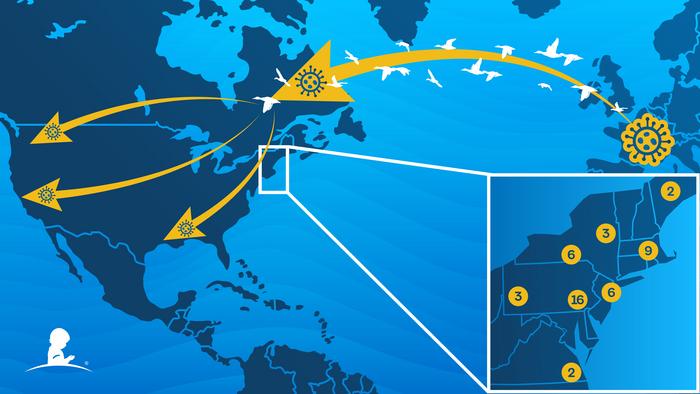(MEMPHIS, Tenn. – May 29, 2023) St. Jude Children’s Research Hospital scientists discovered how the current epizootic H5N1 avian influenza virus (bird flu) gained new genes and greater virulence as it spread west. Researchers showed that the avian virus could severely infect the brains of mammalian research models, a notable departure from previous related strains of the virus. The researchers genetically traced the virus’ expansion across the continent and its establishment in wild waterfowl populations to understand what makes it so different. The study was recently published in Nature Communications.

Credit: Courtesy of St. Jude Children’s Research Hospital
(MEMPHIS, Tenn. – May 29, 2023) St. Jude Children’s Research Hospital scientists discovered how the current epizootic H5N1 avian influenza virus (bird flu) gained new genes and greater virulence as it spread west. Researchers showed that the avian virus could severely infect the brains of mammalian research models, a notable departure from previous related strains of the virus. The researchers genetically traced the virus’ expansion across the continent and its establishment in wild waterfowl populations to understand what makes it so different. The study was recently published in Nature Communications.
“We haven’t seen a virus quite like this one,” said corresponding author Richard Webby, Ph.D., St. Jude Department of Infectious Diseases. “In 24 years of tracing this particular H5N1 flu lineage, we haven’t seen this ability to cause disease but also be maintained in these wild bird populations.”
When the scientists tested the newer avian flu strains for their ability to cause disease in mammals by infecting a ferret model, they found an unexpectedly high amount of pathogenicity.
“Some of these are really nasty viruses,” Webby said. “There’s a huge amount of the virus in the brain of infected animals. That’s the hallmark of what we saw with these flu strains — increased pathogenicity associated with high virus load in the brain. That’s not the first time we’ve seen H5 viruses in the brain, but these are probably some of the most virulent we’ve looked at over 24 years of following these viruses.”
Previous influenza viruses that caused severe disease in North America “burned out” in their main host bird population, and the outbreaks ended quickly. This current strain was detected at high levels in sick chickens but has expanded into other species.
“This is not just a chicken virus now,” Webby said. “It’s also infecting other avian and mammal species in the U.S. It’s a higher exposure risk for humans and other mammals than we’ve ever had in North America. We’ve never really been exposed to this level of circulation of these highly pathogenic flu viruses.”
A low risk to humans (for now)
While the newer strains of this H5N1 influenza show a greater ability to cause disease in mammals than earlier viruses, the scientists found it to be low-risk to humans. This is because the virus appears well-adapted to transmit between birds rather than between mammals.
“Overall, their risk to humans is still low,” Webby said. “But that risk does seem to be changing, and these viruses are doing things that we haven’t seen H5s do before. They’ve come into the continent’s wild bird population, they’ve reassorted, and they’ve been maintained over time. There are now many different types out there, and they’re very nasty.”
Even though the risk of spreading infection is low, the research suggests humans should be cautious interacting with wildlife.
“Someone would have to work pretty hard to infect themselves with this virus. But if they do happen to be infected, there’s a real chance of getting a severe disease from it,” Webby said. “People just need to be careful and remember that some of the wild animals out there potentially harbor these highly pathogenic viruses.”
Genetic change supercharges spread and severity
In the past, similar strains of influenza viruses have not caused similarly severe diseases, nor have they become far-flung in wild bird populations. Since the new strains have done so much more damage, the scientists looked for what was different. The group identified the direct ancestor to the current strains, which spread from Europe to the Americas after gaining a different version of the viral protein, neuraminidase. This new protein increased the virus’s ability to transmit between birds. Then it arrived on the East Coast of Canada and traveled to the United States.
As the researchers studied the virus further, they pinpointed which viruses — distinct from previous ones —caused the current outbreaks. They found that after reaching North America, the virus rapidly changed again to become more virulent. It mixed with flu viruses in North American wild birds, swapping several genes. This reassortment of genes had two effects. One, the virus seemed to become even more adapted to the bird population, infecting many different types of birds. This included atypical hosts, such as buzzards and eagles, which typically do not get the flu. Second, the virus gained its severe disease-causing properties.
“The surprising thing was that just a few reassortment events did change these viruses’ ability to cause disease in our models,” Webby said. “And those events generated many different genotypes from that mixing. Then those viruses spread and have now become established in the North American wild bird population.”
Webby’s group and others continue to monitor the ongoing avian flu pandemic globally to assess its continually evolving risk to both humans and birds.
Authors and funding
The study’s co-first authors are Ahmed Kandeil, Christopher Patton, Jeremy Jones, Trushar Jeevan and Walter Harrington, all of St. Jude. The other authors are Sanja Trifkovic, Jon Seiler, Thomas Fabrizio, Karlie Woodard, Jasmine Turner, Jeri-Carol Crumpton, Lance Miller, Adam Rubrum, Jennifer DeBeauchamp, Charles Russell, Elena Govorkova, Peter Vogel and Lisa Kercher, St. Jude; Mia Kim-Torchetti, National Veterinary Services Laboratories, Animal and Plant Health Inspection Service (APHIS), US Department of Agriculture (USDA); Yohannes Berhane, National Centre for Foreign Animal Disease and the University of Manitoba and David Stallknecht and Rebecca Poulson, The University of Georgia.
The study was supported by grants and contracts from the National Institute of Allergy and Infectious Diseases (HHSN272201400006C, 7 5N93021C00016 and R01AI150745), the National Science Foundation (1911955) and ALSAC, the fundraising and awareness organization of St. Jude.
St. Jude Media Relations Contacts
Michael Sheffield
Desk: (901) 595-0221
Cell: (901) 379-6072
[email protected]
[email protected]
St. Jude Children’s Research Hospital
St. Jude Children’s Research Hospital is leading the way the world understands, treats and cures childhood cancer, sickle cell disease and other life-threatening disorders. It is the only National Cancer Institute-designated Comprehensive Cancer Center devoted solely to children. Treatments developed at St. Jude have helped push the overall childhood cancer survival rate from 20% to 80% since the hospital opened more than 60 years ago. St. Jude shares the breakthroughs it makes to help doctors and researchers at local hospitals and cancer centers around the world improve the quality of treatment and care for even more children. To learn more, visit stjude.org, read St. Jude Progress blog, and follow St. Jude on social media at @stjuderesearch.
Journal
Nature Communications
Method of Research
Experimental study
Subject of Research
Animals
Article Title
Rapid evolution of A(H5N1) influenza viruses after intercontinental spread to North America
Article Publication Date
29-May-2023




